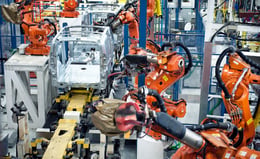Ranking the 5 Biggest Supply Chain Disruptions
Brian Hoey - March 06, 2018

.jpg?width=374&name=Avoiding%20the%20Pitfalls%20of%20Supply%20Chain%20Digitization%20(1).jpg) In the autumn of 1999, Hershey’s was preparing for what they hoped would be a typical Halloween season. By the arrival of the holiday, it would prove to be anything but typical. In fact, the American candy giant would see an almost 10% drop in its stock price over the course of just one day. The reason? A failure to deliver more than $100 million dollars worth of Hershey’s Kisses and Jolly Ranchers candies to stores in time for Halloween. It turns out that Hershey’s had adopted a new order fulfillment system just weeks before their annual Halloween rush, and their IT hadn’t yet been successfully integrated into their value stream. The company would ultimately recover, but the incident still stands as one of history’s biggest supply chain snafus, proving that all supply chains are susceptible to risk and disruptions. Here is a ranking of some of the biggest supply chain disruptions:
In the autumn of 1999, Hershey’s was preparing for what they hoped would be a typical Halloween season. By the arrival of the holiday, it would prove to be anything but typical. In fact, the American candy giant would see an almost 10% drop in its stock price over the course of just one day. The reason? A failure to deliver more than $100 million dollars worth of Hershey’s Kisses and Jolly Ranchers candies to stores in time for Halloween. It turns out that Hershey’s had adopted a new order fulfillment system just weeks before their annual Halloween rush, and their IT hadn’t yet been successfully integrated into their value stream. The company would ultimately recover, but the incident still stands as one of history’s biggest supply chain snafus, proving that all supply chains are susceptible to risk and disruptions. Here is a ranking of some of the biggest supply chain disruptions:
1. Climate Events
Recent years have seen more than their fair share of earthquakes and hurricanes, to say nothing of the more mundane day-to-day weather patterns that can be equally disruptive, and supply chain managers have been struggling to cope. The reason this disruption takes the number one slot on our rankings is twofold: with global climate change these events are poised to become ever more common, and there’s nothing that can be done to prevent them. That said, supply chains can and should be made more flexible in order to increase their ability to respond to the effects of impassable transport routes, factory power outages, and other effects of inclement or catastrophic weather. Transport logistics solutions, for instance, can help supply chain managers to create “what-if” scenarios and contingency plans that enable them to reroute transit through different hubs using real-time information.
2. Fragmentary Information
While climate events are certainly responsible for significant losses in time, stock, and revenue across the entire supply stream, the actual monetary effects of fragmentary information (i.e. siloized decision-making processes, shadow IT infrastructure, etc.) are much harder to calculate. An organization with low data visibility may continue to deliver goods on-time, but it will have extreme difficulty leveraging a lean supply chain or Industry 4.0 principles in a meaningful way. Though information siloes like these are usually endemic to specific businesses, they are in fact a major disruption in the sense that if supply chain planners are denied access to mission critical information due to low data visibility, their ability to perform their jobs can be severely hampered.
Most often, disruptions of this sort occur in businesses that have not adopted a Postmodern ERP approach to resource planning and IT integration. Without an IT infrastructure designed to connect disparate teams and software solutions into one interoperable whole, fragmentary information can become more and more common, especially as disparate business functions come to rely on their specific, disconnected technology solutions, thereby reducing visibility and preventing efficient, holistically-informed resource management.
3. Inaccurate Forecasts
Imagine your production facilities are expecting a seasonal increase in demand for a particular product or part based on similar increases in the previous three years. Assuming that this year will be similar to the last, your production stream is adjusted to produce more of the in-demand part. Then, because of an earlier weather-related parts shortfall halfway across the world, the increase in demand doesn’t occur, and your inventory is over-burdened with excess stock for which there is no demand. Unfortunately, for many businesses this is an all-too-common occurrence, and its effects can be significant, which is why forecasting errors are ranked third on our list of disruptions. When manufacturers rely solely on past demand, they fail to account for the complexity of the global supply chain and the ripple effects it can have. To avoid this type of disruption, manufacturers must drive toward a more digitized supply chain, one that allows for integration with advanced analytics and other forecasting tools that can promote future-oriented planning.
4. New Trade Regulations
As supply chains have become increasingly globalized, fluctuating trade restrictions between different nations have become ever-greater disruptions. In the wake of Brexit, for instance, European manufacturers have had to develop contingency plans based on the possibility of increased complications surrounding any potential hubs or fulfillment centers in Great Britain. Trade regulations can pose a number of logistical concerns, especially for shippers and freight forwarders, and sudden changes can require significant adjustments across a number of business operations:
- Transport logistics must account for potential new slowdowns at border crossings.
- Increases or decreases in tariffs require a reevaluation of a given company’s global supply stream.
- Potential demand fluctuations must be accounted for in production plans.
5. Oil and Other Price Fluctuations
Oil and other price fluctuations rank lower than new trade regulations largely because the latter can often encompass the former, particularly for manufacturers operating in nations dependent on foreign energy sources. That said, sudden changes in price throughout various touch-points in a company’s value stream can dramatically increase production and transport costs, potentially cutting into revenue or forcing price increases that risk alienating customers. Supply chains that are low on visibility and flexibility or are otherwise siloized can be especially susceptible to this type of disruption. Businesses that embrace end-to-end (E2E) visibility and Industry 4.0 principles, on the other hand, will have the built in agility to respond to changing scenarios in a flexible, value-additive manner.
LATEST POSTS
- Understand Why Production Planning Needs Specialized Solutions
- Understand Circular Economy in The Manufacturing Industry
- How Can Industry 4.0 IT Integration Be Achieved Smoothly?
- The Significance of Order Sequencing in Discrete Manufacturing
- How to improve your Supply Chain Management: The Power of Control Towers



